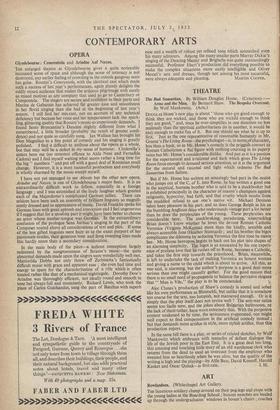ART
Rowlandson. (Whitechapel Art Gallery.
THE licentious soldiery clump around on their peg-legs mid elope with the young ladies at the Boarding School ;buxom wenches are hauled up through the undergraduates' windows in bosun's chairs ; coaches crash over bridges into foaming streams ; boats are wrecked and oxen draw the salvage up the beaches ; the apples roll across the road ; the dogs snap and bark ; tipsy brawls break out in the taverns ; children scream ; male hands feel their way to female breasts ; wigs are snatched ; the artillery embark. Scarcely time to get it all down with the reed pen and to splash the rosy wash on top before more Comes teeming and crowding into view, for a man has his living to earn and prints galore to make and sell. How rich, how real, how English we feel, as Rowlandson goes roistering through the eighteenth into the nineteenth century !
Heresy toJecall that Rowlandson's style is a direct continuation of the French rococo tradition ; that his affinities with Balzac are at least as strong as those with Dickens ; that he was unaffected by his own contemporaries and failed to affect them or their successors. He seems remote from his contemporary Gillray, with whom he hangs in the Whitechapel Art Gallery. They shared only in that exploitation of physical deformity which—since the gods laughed at limping Vulcan—has been the mainstay of the caricaturist. But whereas Rowlandson's warty excrescences and strawberry noses are without real malice—Michael Ayrton has truly said that they are like a school- boy's drawings of " teacher "—Gillray's turbulent images are the product of a sustained indignation and an introverted mind. Bitter- ness to„the point of hysteria overcrowds his compositions (he did in fact lose his sanity and horror vacui is a recurrent factor in madhouse drawings). Occasionally, as we gaze upon the extinct volcano of his hatreds, a fragmentary image, like the screaming child in The Butchers of Freedom, flickers into life with the universality of a Goya, but all too often the literary symbolism of his drawings is too compact and too remote to seem worth disentangling to any but a social historian. Here he and Rowlandson part company. The one is locked within his period ; the other has a quality of universality. The harsh brightness of Gillray's prints is that of the ballad sheet and the painted barge ; the pale drawings of Rowlandson are authentic glimpses of an Arcadia blasted out of existence by the Industrial Revolution. The sweetness of the idyll is prevented from cloying by the briskness of the handwriting and the validity of the observation. Gillray sustained a lifelong savagery, but Rowlandson was a man of many, many moods: M. H. MIDDLETON.



























































 Previous page
Previous page